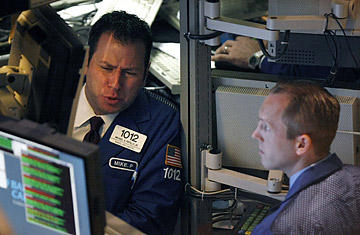
Traders on the floor of the New York Stock Exchange.
Bull markets, so they say, climb a wall of worry. But some market watchers see the current wall as just too steep.
"The market has priced in an average recession," says Ed Yardeni, a Wall Street economist. "Anything beyond that and the market will have more to fall."
The biggest concern is that investors and banks might not be willing to take risks at the start of a recession, even a typical one. Without rising share prices or loans, it is very hard for corporate executives to expand their businesses, or in some cases even stay afloat. Given that, some market watchers are concerned that analysts might still have a too rosy picture of what many companies could earn in the next year.
"We can say that stock valuations look cheap," says Sam Stovall, chief investment strategist at Standard & Poor's. "But if the earnings portion of the price-to-earnings ratio is in question, then how can you say stocks are attractive?"
Still, investors do seem to be more positive about the market. After what was one of the worst months on record, the market, as measured by the S&P 500, has risen 10% in the past week, and was up for most of the day Monday, before ending just a few points down. That's pretty incredible in face of such continued downers as the news Monday that car sales by U.S. automakers dropped by more than 30% in October.
Some market watchers, though, think the current rally is not the product of more optimism about the economy, just less pessimism. And there's a big difference, they say. In report out Monday from Merrill Lynch, the analysts at that brokerage firm compared the number of trades in stocks that were falling, and the number of trades in stocks that were rising. THey found that most of the activity in the market was happening in stocks that were slumping. Their conclusion: The current market rally is a result of a lack of sellers and not a stampede of buyers. "Sellers are moving away from the market and that's why stocks are headed up," says Mary Ann Bartels, chief market analyst at Merrill Lynch. "We have seen this before in other rallies this year, and what happens is the market can't continue to go up without buyers."
Bartels says her research suggests that the market could be stuck in neutral or worse for the next year. "We think the market could lose another 12% from its lows, which would be a drop of about 20% from here," says Bartels. "Don't unbuckle your seatbelt yet."
And it's not just investors who are shying away from betting on corporate America. Banks, too, despite all of the government's best efforts, continue to be reluctant to extend credit to companies. Yardeni notes that in the past six weeks the amount of cash banks are holding has more than doubled to just over a half a trillion dollars, which is nearly a record. Bank lending is up, but Yardeni says that much of the measured increase comes from financial firms like Goldman Sachs and Morgan Stanley being recategorized as banks. "Banks are piling up liquid assets much faster than they are making loans," says Yardeni. "And that's not a good thing."
Lastly, it seems that stock analysts are still predicting too positive a picture for the companies they cover. Standard & Poor's recently polled stock analysts and found that together they believe the companies in the S&P 500 will earn $94.24 a share in 2009 in operating earnings. Not bad. By that measure, the S&P index has a p/e of 10.3, which is historically very cheap. Back in the late 1990s, the index had a p/e of 29.
The problem, says S&P's chief economist David Wyss, who looks at GDP and employment and other broad indicators of the economy, is that S&P earnings could end up about 50% lower, or $63 per share. Stocks analyst are typically more optimistic than economists, but only by a few bucks, says Howard Silverblatt, an index analyst at S&P. "Traditionally, when you get these big discrepancies, it is the economists who end up being a lot closer to reality," says Silverblatt.
Add in all the charges companies will be making this year to get devalued assets off their books and you wind up with a projection of $48.52 a share for the collective bottom line of the S&P 500, and a p/e of nearly 20. That means stocks would have to fall considerably more before they appeared cheap.
"Our indicators do not show a broad-based rally," says Tim Hayes, senior equity strategist at Ned Davis Research. "Most likely the market is in a bottoming out process that will continue to test the lows."
Consumer Confidence Plunges, but the Stock Market Soars
